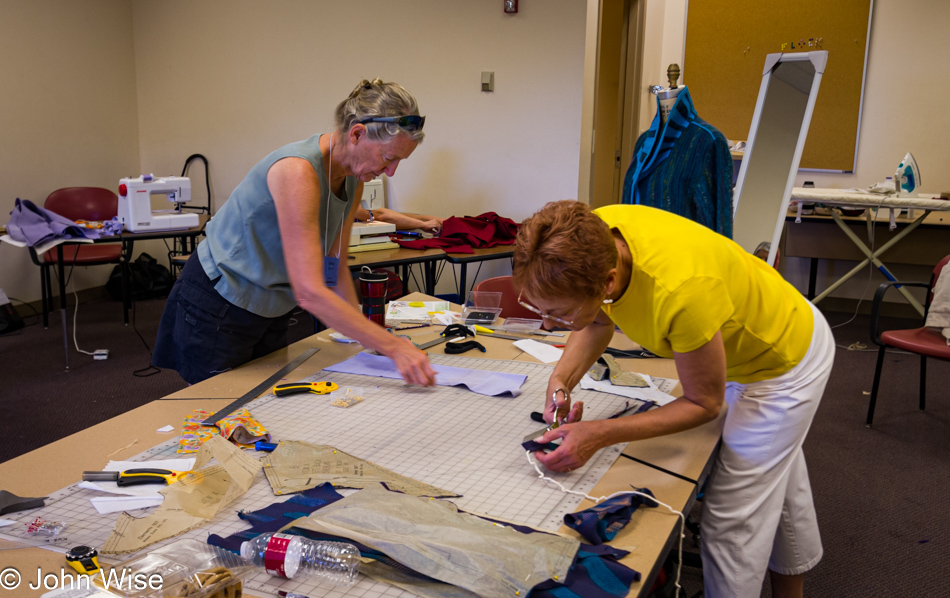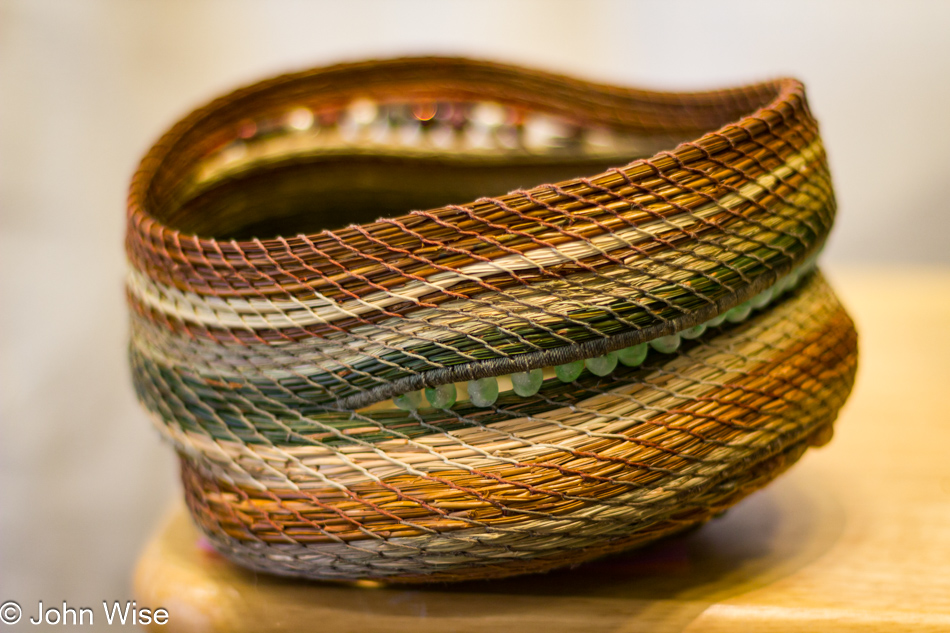
Here she is, my fiber-addicted wife, Caroline Wise. Metamucil, you ask; maybe oatmeal or whole wheat bread is her fiber of choice? Heck no, all that would be cheap compared to someone who has joined the flock of weavers, spinners, basket makers, dyers, knitters, and other assorted people who enjoy the hobby that takes over all of your space. Fiber artists don’t have anything like Knitters Anonymous; they have the exact opposite: Fiber Guilds.
— Please Take Note: well after this was all posted, I decided to merge some of the workshop images onto their date-appropriate pages so things coincided with when they were happening. I chose not to delete this post, which is mostly duplicated now, as this page has received so many visits that I don’t want it to just disappear from the search engines.

And what do guilds do? They organize workshops, retreats, and classes. They write books and magazine articles and produce videos. Bands of merchants selling the hot wares follow this tribe around to encourage further consumption and great new projects yet to be spun, frogged, carded, and strewn about as dozens of UFOs – Un-Finished Objects.

Ever heard of dyeing fabric with mud? Forget your Dolce & Gabbana; we’re going stone age and wearing mud again. I’m not even sure then why we must first put it on fabric instead of just rolling around in the stuff. To be fair, this method of dyeing with mud is called Bogolanfini, a traditional African method – albeit one modified by Judy Dominic. Judy particularly enjoys the inspiration of the designs used by the people of Mali.

Try pronouncing Katazome or Shibori. Katazome is a paste-resist dyeing method using rice paste, soy milk, various pigments, and a lot of indigo. It was this class given by John Marshall here in Durango, Colorado at the campus of Fort Lewis that brought us to the Intermountain Weavers Conference. Every other year, IWC hosts a fiber hoedown that attracts members and non-members alike to spend three days trying new fiber drugs. Trust me, it is not uncommon to hear someone asking to borrow a needle.

John Marshall teaches his students this old Japanese art of Katazome that is quickly disappearing as modern manufacturing processes and the desire for inexpensive clothing make this a dying craft. After the students applied pigments and paste resist materials and probably some other processes in an order I have no clue about, they would dip their work into a vat of indigo. As the cloth is pulled from the indigo, it is still green, as were the leaves that went into the vat that makes indigo.

The magic of indigo happens as the materials are exposed to the air; they begin to oxidize. This oxidation process is what turns the fabric that familiar blue we are all aware of. Depending on what is being dyed, the fabric can turn deep shades of blue, as do fingers and even the hair of one of the ladies in Caroline’s class. Hey Nancy, not sure what I think of blue bangs on white hair, though it wasn’t bad. Maybe this will inspire this grandmother-aged sweet lady to now consider a tattoo of an alpaca with crossed shears. Argh.

The other word I introduced you to was Shibori. Shibori is an ancient Japanese fiber art similar to the Rajashtahni and Gujarati craft of Bandhani. These two styles of dyeing can involve an incredible amount of handwork. Small or even larger segments of cloth are wrapped, stitched, folded, twisted, and bound with string; at times, hundreds, even thousands, of the wrapped bundles are applied to a piece of cloth. This slows down and can stop the dye from reaching all of the cloth as it is dipped in dye to produce beautiful patterns. Now, think of where you may have seen or heard of a cloth that is a descendant of this process. It sounds a bit like Bandhani; how about the good old Bandana? Bet you didn’t know that it wasn’t the hippies of the 1960s who invented Tie Dye.

After much work and a ton of international coordination, the board members of IWC were able to convince the renowned Scholar, Curator, and Artist Yoshiko Iwamoto Wada to lead a workshop teaching this art form known as Shibori. Ms. Wada not only taught an overflowing class of enthusiastic students, but she was also the Keynote Speaker of the conference. With nothing else going on that night, I stuck around to listen, good thing I did. While fiber arts may not be my specialty, I can certainly appreciate the craft and skill that goes into this work. During the presentation, we learned of the work of a number of artists working in Japan that elicited the oohs and aahs of the overheated theater that reached its seating capacity. Some of the artists who truly made an impression on me were Jurgen Lehl, Christina Kim, and the guys behind Sou.Sou; Tsuyoshi Wakabayashi, Katsuji Wakisaka, and Hisanobu Tsujimura.

The grounds of Fort Lewis are spread out, although it may have only felt that way because Durango sits at 6,512 feet above sea level (1984m). On one end of the campus was the Student Union building, where check-in, the cafeteria, and merchants were located. In a nearby building, five or six classes were being held; next door to that was the theater. On the way north across campus was another building where a few classes were taking place, followed by the Arts building where Caroline’s class and five others were going on. At the far north, a juried fiber exhibit was taking place.

Vegetarian trophy heads. I didn’t see this one coming. For those who enjoy a little stuffed head taxidermy of a trophy kill but would like to be animal cruelty-free while admiring the beast mounted on the wall, try knitting your own. That’s just what this young 22-year-old woman, Syndi Roberts, did. I wonder if I found a dead bear someday out on the trail that died of natural causes, and I shorn that old bear to bring the fiber home to Caroline. Could she spin my bear fur into yarn and knit me up a bear head? I’d imagine that I would be the envy of all my tree-hugging buddies.

From furry heads to hot bodies. What kind of fibery workshop/festival event would be complete without a fashion show? A bad one, the Intermountain Weavers didn’t disappoint. This 80-something-year-old babe stole the show with her soon-to-be trendy again swimsuit that dragged out the wolf whistles. Betty relished the attention, strutting her figure while notching up the temperature in the theater another few degrees. She pranced left, sashayed right, and flaunted every bit of sexy she could muster.

From the bodacious to the lascivious. This show had it all, including this kinky master/slave display featuring elements of domination and bestiality from two bad-ass grannies who knew how to get the kink on. Sure, they wrapped it in some innocuous Mary Had A Little Lamb skit, but I knew the sub-context; nothing is lost on me or my vivid imagination.

The next day, things went back to normal, and the attendees got back to serious craft. Caroline was now ready to start dyeing her designs on hemp cloth. With her rubber gloves and apron, there would be no turning her skin or hair blue. John Marshall was pushing his students to complete half a dozen projects, teaching them the art of Katazome.

During my relatively short stay on campus, I took some time to visit all of the classrooms to see what else was on offer. In this class, maybe a dozen people were working on improving their tapestry loom skills. It was also possible this was the first time on such a loom; I didn’t want to disturb the instructors, so I simply stuck my head in, snapped a few photos, and left.

This weaving workshop was specializing in creating stripes. The patterns and techniques that have been developed over the previous 20,000 years by the hands of countless human beings across all geographical regions of our planet are as diverse as there are sunrises in one’s life. If we are fortunate, these women who are keeping these arts alive will inspire a new generation to pick up the craft, and with any luck, some of the history, skills, and methods will find their way onto video to be shared with future generations. You see, I have this hope that at some point in our evolution, we humans will become enlightened, and through the work of the many minds who are creating ever greater efficiencies, humans will learn to enjoy their time where learning and crafts lead the day as opposed to rushing around responding to non-sensical information and the demands of work.

Advancing one’s skills or learning new ones is a goal of these workshops. Here, these two women are working to expand their knowledge of sewing. Maybe this is also an opportunity to rub shoulders with like-minded individuals and get away from spouses who may not be exactly supportive of these hobby crafts. The most striking aspect of my short visits to these events is the camaraderie exhibited between attendees. There is no hesitation to share tips and tricks; there is no bragging about statistics that put one person in a bragging position where their expertise creates celebrity – most of the time!

This is an example of the final outcome. Spend years perfecting the techniques that broaden the ability to discern the beauty in patterns and then deploy those skills to inspire your fellow artists. This handwoven shawl was on display in the non-juried Intermountain Spirit exhibit, with attending members encouraged to submit their best work, too.

My vote for best of show would have been this handwoven basket. The irregular shape and southwest mountain colors with a fine band of green glass beads really worked for me. And people think basket weaving is a boring chore for retirees with nothing better to do, as though staring at a small screen and tapping out messages in 140 characters or less is a statement of the pinnacle of sophistication people have attained. Do I sound bitter about the neglect of our skills, intellect, and respect for those who learn? Well, I guess I am – oh, how I wish humanity would find its next renaissance.

The culmination of Caroline’s efforts at the Intermountain Weavers Conference 2011 event in Durango, Colorado. Next year, she will likely attend Fibers Through Time 2012 to be held in Phoenix, Arizona. If we are still living in the southwest the following year, I wouldn’t imagine it as being too far a stretch that she will once again find herself in Durango attending IWC 2013.